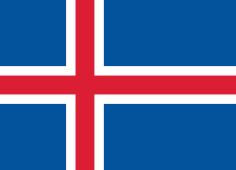This article needs additional citations for verification. (May 2017) |
 | |
| Use | Civil flag and ensign |
|---|---|
| Proportion | 18:25[1] |
| Adopted | 17 June 1944 (standardization from 1918) |
| Design | A blue field with the white-edged red Nordic cross that extends to the edges; the vertical part of the cross is shifted to the hoist side. In Blazon, "Azure, a cross gules fimbriated argent". |
| Designed by | Matthías Þórðarson |
 | |
| Use | State and war flag, state and naval ensign |
| Proportion | 9:16[1] |

 The flag of the president of Iceland. It has an aspect ratio of 9:16.
The flag of the president of Iceland. It has an aspect ratio of 9:16.
 The flag of the Icelandic Customs Service. It has an aspect ratio of 9:16.
The flag of the Icelandic Customs Service. It has an aspect ratio of 9:16.The flag of Iceland (Icelandic: íslenski fáninn) was officially described in Law No. 34, set out on 17 June 1944, the day Iceland became a republic. The law is entitled "The Law of the National Flag of Icelanders and the State Arms" and describes the Icelandic flag as follows:
The civil national flag of Icelanders is blue as the sky with a snow-white cross, and a fiery-red cross inside the white cross. The arms of the cross extend to the edge of the flag, and their combined width is 2⁄9, but the red cross 1⁄9 of the combined width of the flag. The blue areas are right angled rectangles, the rectilinear surfaces are parallel and the outer rectilinear surfaces as wide as them, but twice the length. The dimensions between the width and length are 18:25.
Iceland's first national flag was a white cross on a deep blue background. It was first shown in parade in 1897. The modern flag dates from 1915, when a red cross was inserted into the white cross of the original flag. This cross historically stems from the symbol of Christianity.[2][3] It was adopted and became the national flag when Iceland was granted sovereignty by Denmark in 1918. For Icelanders, the flag's colouring represents a vision of their country's landscape. The colours stand for three of the elements that make up the island. Red is the fire produced by the island's volcanoes, white recalls the ice and snow that covers Iceland and blue represents the mountains of the island.[4]
- ^ a b Icelandic National Flag Proportion - Prime Minister's Office
- ^ Jeroen Temperman (2010). State Religion Relationships and Human Rights Law. Martinus Nijhoff Publishers. ISBN 978-9004181489. Retrieved 2007-12-31.
Many predominantly Christian states show a cross, symbolising Christianity, on their national flag. Scandinavian crosses or Nordic crosses on the flags of the Nordic countries–Denmark, Finland, Iceland, Norway and Sweden–also represent Christianity.
- ^ Carol A. Foley (1996). The Australian Flag: Colonial Relic or Contemporary Icon. William Gaunt & Sons. ISBN 9781862871885. Retrieved 2007-12-31.
The Christian cross, for instance, is one of the oldest and most widely used symbols in the world, and many European countries, such as the United Kingdom, Norway, Sweden, Finland, Denmark, Iceland, Greece and Switzerland, adopted and currently retain the Christian cross on their national flags.
- ^ "History of the Icelandic Flag". www.government.is. Prime Minister's Office. Retrieved 2019-03-02.